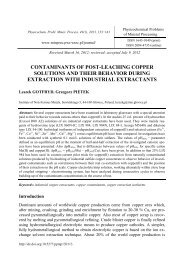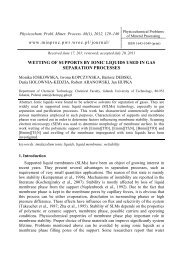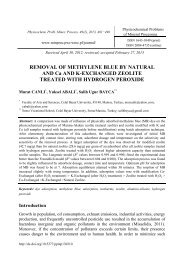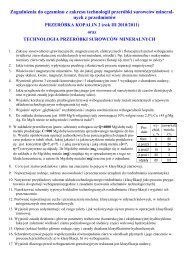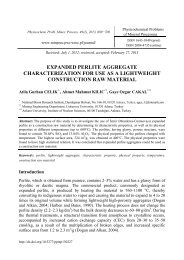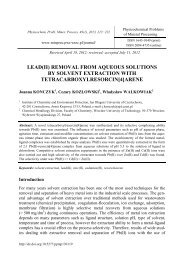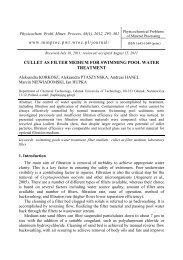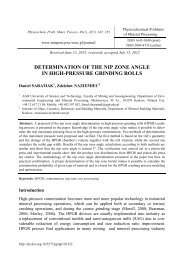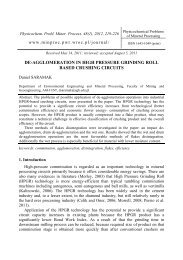Influence of acid activation on the ion-exchange properties of ...
Influence of acid activation on the ion-exchange properties of ...
Influence of acid activation on the ion-exchange properties of ...
- No tags were found...
You also want an ePaper? Increase the reach of your titles
YUMPU automatically turns print PDFs into web optimized ePapers that Google loves.
Physicochem. Probl. Miner. Process. 48(2), 2012, 591−598w w w . m i n p r o c . p w r . w r o c . p l / j o u r n a l /Physicochemical Problems<str<strong>on</strong>g>of</str<strong>on</strong>g> Mineral ProcessingISSN 1643-1049 (print)ISSN 2084-4735 (<strong>on</strong>line)Received February 26, 2012; reviewed; accepted May 3, 2012INFLUENCE OF ACID ACTIVATION ON THE ION-EXCHANGEPROPERTIES OF MANISA-GORDES CLINOPTILOLITEAbdulkerim YORUKOGLUMTA Genel Mudurlugu, Mineral Research and Explorati<strong>on</strong> General Directorate, Dumlupinar Bulvari No:139,06800-Ankara, Turkey, kerim@mta.gov.trAbstract. In this study, <strong>the</strong> possibilities <str<strong>on</strong>g>of</str<strong>on</strong>g> using Manisa-Gördes district tuffs having importantdeposits rich <str<strong>on</strong>g>of</str<strong>on</strong>g> clinoptilolites have been investigated for <strong>the</strong> removal <str<strong>on</strong>g>of</str<strong>on</strong>g> heavy metal i<strong>on</strong>s fromindustrial wastewaters. Adsorpti<strong>on</strong> <str<strong>on</strong>g>of</str<strong>on</strong>g> amm<strong>on</strong>ium and metal cati<strong>on</strong>s such as Pb ++ , Cu ++ , Cd ++and Zn ++ i<strong>on</strong>s from aqueous soluti<strong>on</strong> <strong>on</strong>to sulphuric, hydrochloric and nitric <str<strong>on</strong>g>acid</str<strong>on</strong>g> activatedsamples were studied. Experimental data were obtained from batch equilibrium tests <strong>on</strong>samples activated at different <str<strong>on</strong>g>acid</str<strong>on</strong>g> c<strong>on</strong>centrati<strong>on</strong>s at two different size fracti<strong>on</strong>s. It has beenfound that selectivity <str<strong>on</strong>g>of</str<strong>on</strong>g> <strong>the</strong> zeolite is sequentially Pb ++ > NH 4 + > Cu ++ , Cd ++ > Zn ++ .Experimental results show that <strong>the</strong> NH 4 + i<strong>on</strong> <strong>exchange</strong> capacity <str<strong>on</strong>g>of</str<strong>on</strong>g> 95 meq/100 g for <strong>the</strong> rawmaterial can be increased to 140 meq/100 g after <str<strong>on</strong>g>activati<strong>on</strong></str<strong>on</strong>g> with sulphuric <str<strong>on</strong>g>acid</str<strong>on</strong>g>. In general,<str<strong>on</strong>g>acid</str<strong>on</strong>g> <str<strong>on</strong>g>activati<strong>on</strong></str<strong>on</strong>g> was observed to increase <strong>the</strong> i<strong>on</strong> <strong>exchange</strong> capacity, sulphuric <str<strong>on</strong>g>acid</str<strong>on</strong>g> resp<strong>on</strong>dingbetter than hydrochloric and nitric <str<strong>on</strong>g>acid</str<strong>on</strong>g>s.keywords: zeolite, clinoptilolite, <str<strong>on</strong>g>acid</str<strong>on</strong>g> <str<strong>on</strong>g>activati<strong>on</strong></str<strong>on</strong>g>, i<strong>on</strong> <strong>exchange</strong>1. Introducti<strong>on</strong>Natural zeolite minerals are hydrated aluminosilicates <str<strong>on</strong>g>of</str<strong>on</strong>g> alkaline and alkalineearthcati<strong>on</strong>s with indefinitely extending three dimensi<strong>on</strong>al network <str<strong>on</strong>g>of</str<strong>on</strong>g> (Si, Al)O 4tetrahedral linked to each o<strong>the</strong>r by sharing all <str<strong>on</strong>g>of</str<strong>on</strong>g> <strong>the</strong> oxygen. Their structure c<strong>on</strong>tainchannels and pores that are occupied by mobile cati<strong>on</strong>s and water molecules. Due to<strong>the</strong>ir structural characteristics, natural zeolites especially clinoptilolites are used formany purposes related with <strong>the</strong>ir i<strong>on</strong> <strong>exchange</strong>, adsorpti<strong>on</strong>, dehydrati<strong>on</strong> andrehydrati<strong>on</strong> <strong>properties</strong> (Castaldi et al., 2008; Girgin et al., 1996; Englert and Rubio,2005; Wang and Peng, 2010, Cincotti et al., 2001; Korkuna et al., 2006).Clinoptilolites are capable <str<strong>on</strong>g>of</str<strong>on</strong>g> exchanging alkaline and alkaline-earth cati<strong>on</strong>s inaqueous soluti<strong>on</strong>s and studies have been c<strong>on</strong>ducted <strong>on</strong> <strong>the</strong> waste water and nuclearwaste treatment for <strong>the</strong> removal <str<strong>on</strong>g>of</str<strong>on</strong>g> some harmful cati<strong>on</strong>s (Ata and Girgin, 1994;Erdem et al., 2004; Curkovic et al., 1997; Toprak and Girgin, 2000; Gunay et al.,2007; Motsi et al., 2009; Ouki and Kavannagh, 1999; Abusafa and Yucel, 2002; Boraiet al., 2009). They <str<strong>on</strong>g>of</str<strong>on</strong>g>fer advantages over organic-i<strong>on</strong> <strong>exchange</strong>rs due to <strong>the</strong>ir highchemical, <strong>the</strong>rmal and radiati<strong>on</strong> stabilities. Their i<strong>on</strong>-<strong>exchange</strong> and adsorpti<strong>on</strong>http://dx.doi.org/10.5277/ppmp120222
592 A. Yorukoglu<strong>properties</strong> can be improved by <strong>the</strong>rmal and <str<strong>on</strong>g>acid</str<strong>on</strong>g> <str<strong>on</strong>g>activati<strong>on</strong></str<strong>on</strong>g> methods (Girgin et al.,1996; Wang and Peng, 2010; Curkovic et al., 1997; Inglezakis, 2005; Modale et al.,1995; Toprak and Girgin, 1999) .This study was aimed at determining <strong>the</strong> cati<strong>on</strong>-<strong>exchange</strong> capacity <str<strong>on</strong>g>of</str<strong>on</strong>g> Manisa-Gördes clinoptilolites for Pb +2 , NH 4 + , Cu +2 , Ca +2 and Zn +2 after <str<strong>on</strong>g>activati<strong>on</strong></str<strong>on</strong>g> with H 2 SO 4 ,HCl and HNO 3 .2. Experimental2.1. Chemicals and reagentsMerck grade HCl, H 2 SO 4 and HNO 3 were used in <strong>the</strong> <str<strong>on</strong>g>acid</str<strong>on</strong>g>-<str<strong>on</strong>g>activati<strong>on</strong></str<strong>on</strong>g> experiments.Soluti<strong>on</strong>s used in i<strong>on</strong> <strong>exchange</strong> tests were prepared using CH 3 COONH 4,Cu(CH 3 COO) 2 . H 2 O, Pb(CH 3 COO) 2 . 3H 2 O, Zn(CH 3 COO) 2 . 2H 2 O, Cd(CH 3 COO) 2 . 2H 2 Oand KCl (analytical grade Merck reagents).2.2. Preparati<strong>on</strong> and characterizati<strong>on</strong> <str<strong>on</strong>g>of</str<strong>on</strong>g> <strong>the</strong> sampleClinoptilolite-rich tuff samples taken from Manisa-Gördes regi<strong>on</strong> was used in <strong>the</strong>experiments. Representative samples were crushed using jaw, c<strong>on</strong>e and roll crushers,and <strong>the</strong>n wet screened to -0,3 mm. After washing with distilled water and acet<strong>on</strong>e, -707 +595 µm and -500 +298 µm fracti<strong>on</strong>s were obtained in i<strong>on</strong>-<strong>exchange</strong>experiments.The chemical compositi<strong>on</strong> <str<strong>on</strong>g>of</str<strong>on</strong>g> <strong>the</strong> sample determined by XRF analysis (RigakuRIX-3000 Spectrometer) is given in Table 1.Table 1. Chemical compositi<strong>on</strong> <str<strong>on</strong>g>of</str<strong>on</strong>g> <strong>the</strong> sample usedComp<strong>on</strong>ent %SiO 2 71.29Al 2 O 3 13.55Fe 2 O 3 1.15CaO 2.45MgO 0.70Na 2 O 0.60K 2 O 3.50LOI 6.43XRD analysis (Rigaku Geiger Flex X ray) shows that <strong>the</strong> main mineral isclinoptilolite and cristobalite is present in minor quantities (Fig. 1a). XRD patterns <str<strong>on</strong>g>of</str<strong>on</strong>g><strong>the</strong> sample treated between 100-1000ºC (Fig. 1b) show lowering in <strong>the</strong> peak intensities<str<strong>on</strong>g>of</str<strong>on</strong>g> clinoptilolite lattice c<strong>on</strong>centrati<strong>on</strong> and <strong>the</strong>rmal collapse <str<strong>on</strong>g>of</str<strong>on</strong>g> <strong>the</strong> framework at 800 0 C .The TG/DTA data (Rigaku TAS 100 Thermo flex TG 8110) is in agreement with <strong>the</strong>
<str<strong>on</strong>g>Influence</str<strong>on</strong>g> <str<strong>on</strong>g>of</str<strong>on</strong>g> <str<strong>on</strong>g>acid</str<strong>on</strong>g> <str<strong>on</strong>g>activati<strong>on</strong></str<strong>on</strong>g> <strong>on</strong> <strong>the</strong> i<strong>on</strong>-<strong>exchange</strong> <strong>properties</strong> <str<strong>on</strong>g>of</str<strong>on</strong>g> Manisa-Gordes clinoptilolite 593XRD results showing c<strong>on</strong>tinuous hydrati<strong>on</strong> up to 700 0 C with release <str<strong>on</strong>g>of</str<strong>on</strong>g> water and anexo<strong>the</strong>rmic event at around 924ºC due to <strong>the</strong> collapse <str<strong>on</strong>g>of</str<strong>on</strong>g> <strong>the</strong> structure (Fig. 2).C<strong>on</strong>sidering <strong>the</strong> K, Na, Ca, Mg c<strong>on</strong>tents <str<strong>on</strong>g>of</str<strong>on</strong>g> <strong>the</strong> sample, <strong>the</strong>oretical cati<strong>on</strong> <strong>exchange</strong>capacity was calculated as 120.74 meq/100g. Also, specific surface area, porediameter, pore volume and <strong>the</strong> density (Quantachrome Nova 2000) <str<strong>on</strong>g>of</str<strong>on</strong>g> <strong>the</strong> sample weredetermined as 43.91 m 2 /g, 0.018 μm, 0.1717 cm 3 /gr, 2.12 g/cm 3 , respectively.Figure 3 shows <strong>the</strong> electr<strong>on</strong>microscopic view <str<strong>on</strong>g>of</str<strong>on</strong>g> <strong>the</strong> sample (FEI Qanta 400 MK2electr<strong>on</strong>microscope) where macro and micropores can clearly be seen between <strong>the</strong>clinoptilolite crystals (Fig. 3d).(a)(b)Fig. 1. a)XRD pattern <str<strong>on</strong>g>of</str<strong>on</strong>g> <strong>the</strong> sample b) XRD patterns <str<strong>on</strong>g>of</str<strong>on</strong>g> <strong>the</strong> sample between 100−1000ºCFig. 2. TG/DTA curves <str<strong>on</strong>g>of</str<strong>on</strong>g> <strong>the</strong> sample
594 A. Yorukoglu(a)(b)(c)Fig. 3. An electr<strong>on</strong>microscopic view <str<strong>on</strong>g>of</str<strong>on</strong>g> Manisa-Gördes clinoptolite (a) ~1000x magnificati<strong>on</strong>,(b) ~4000x magnificati<strong>on</strong>, (c) ~6000x magnificati<strong>on</strong>, (d) ~8000x magnificati<strong>on</strong>(d)2.3. Acid <str<strong>on</strong>g>activati<strong>on</strong></str<strong>on</strong>g> and i<strong>on</strong> <strong>exchange</strong> testsIn <strong>the</strong> <str<strong>on</strong>g>acid</str<strong>on</strong>g> <str<strong>on</strong>g>activati<strong>on</strong></str<strong>on</strong>g> experiments, <strong>the</strong> sample was treated with <str<strong>on</strong>g>acid</str<strong>on</strong>g> soluti<strong>on</strong>s <str<strong>on</strong>g>of</str<strong>on</strong>g>varying c<strong>on</strong>centrati<strong>on</strong>s (0.1, 0.5, 1.0, 2.0 M) for <strong>on</strong>e hour at room temperature.Following filtrati<strong>on</strong>, <strong>the</strong> samples were washed with water, <strong>the</strong>n with acet<strong>on</strong>e andfinally were dried at 105ºC for 24 hours.In <strong>the</strong> cati<strong>on</strong> <strong>exchange</strong> tests, 1 gram <str<strong>on</strong>g>of</str<strong>on</strong>g> sample was treated with 100 cm 3 <str<strong>on</strong>g>of</str<strong>on</strong>g> soluti<strong>on</strong>for 8 hours in a 250 cm 3 beaker with mechanical agitati<strong>on</strong> at c<strong>on</strong>stant speed to keep all<strong>the</strong> particles in suspensi<strong>on</strong>. After completi<strong>on</strong> <str<strong>on</strong>g>of</str<strong>on</strong>g> <strong>the</strong> reacti<strong>on</strong>, <strong>the</strong> samples wereseparated by filtrati<strong>on</strong> and rinsed with methanol. For <strong>the</strong> stripping <str<strong>on</strong>g>of</str<strong>on</strong>g> <strong>exchange</strong>dcati<strong>on</strong>s, loaded samples were treated with 100 cm 3 <str<strong>on</strong>g>of</str<strong>on</strong>g> KCl soluti<strong>on</strong> for 8 hours, filteredand <strong>the</strong> soluti<strong>on</strong>s were analyzed. As <strong>the</strong> adsorpti<strong>on</strong> <str<strong>on</strong>g>of</str<strong>on</strong>g> Pb +2 <strong>on</strong> clinoptilolite wasirreversible, <strong>the</strong> samples were <strong>exchange</strong>d with K + before treatment with Pb +2 soluti<strong>on</strong>and <strong>the</strong> extent <str<strong>on</strong>g>of</str<strong>on</strong>g> Pb +2 <strong>exchange</strong> was determined by K + analysis in <strong>the</strong> soluti<strong>on</strong>.
CEC, meq/100grCEC, meq/100grCEC, meq/100grCEC, meq/100gr<str<strong>on</strong>g>Influence</str<strong>on</strong>g> <str<strong>on</strong>g>of</str<strong>on</strong>g> <str<strong>on</strong>g>acid</str<strong>on</strong>g> <str<strong>on</strong>g>activati<strong>on</strong></str<strong>on</strong>g> <strong>on</strong> <strong>the</strong> i<strong>on</strong>-<strong>exchange</strong> <strong>properties</strong> <str<strong>on</strong>g>of</str<strong>on</strong>g> Manisa-Gordes clinoptilolite 595Amm<strong>on</strong>ium i<strong>on</strong> was determined by colorimetric method and <strong>the</strong> o<strong>the</strong>r i<strong>on</strong>s wereanalyzed using <strong>the</strong> atomic absorpti<strong>on</strong> spectrophotometric method.The batch technique was used for measurement <str<strong>on</strong>g>of</str<strong>on</strong>g> cati<strong>on</strong> <strong>exchange</strong> capacity <str<strong>on</strong>g>of</str<strong>on</strong>g>samples (Sub-Committee, 1994) and <strong>the</strong> cati<strong>on</strong> <strong>exchange</strong> capacities (CEC) inmeq/100g were determined using equati<strong>on</strong>:CEC (meq/100g) = (milimoles <str<strong>on</strong>g>of</str<strong>on</strong>g> sorbed i<strong>on</strong> / 100g sample) (cati<strong>on</strong> valence).3. Results and discussi<strong>on</strong>The NH 4+<strong>exchange</strong> capacities for <strong>the</strong> raw sample were determined as 94 meq/100gand 100 meq/100 g for sample sizes <str<strong>on</strong>g>of</str<strong>on</strong>g> +595 m and +298 m, respectively. Theeffect <str<strong>on</strong>g>of</str<strong>on</strong>g> particle size and <str<strong>on</strong>g>acid</str<strong>on</strong>g> c<strong>on</strong>centrati<strong>on</strong> were c<strong>on</strong>sidered in <strong>the</strong> i<strong>on</strong> <strong>exchange</strong>experiments and <strong>the</strong> results for <str<strong>on</strong>g>acid</str<strong>on</strong>g> activated samples are given in Fig. 4.150+595 m +298 m15015HCl+595 m +298 mH2SO41512512510HNO31010010075HCl75H2SO4HNO350500 0,5 1 1,5 2Acid C<strong>on</strong>cenrati<strong>on</strong>, M55000 0,5 1 1,5 2Acid C<strong>on</strong>cenrati<strong>on</strong>, MFig. 4. NH 4 + <strong>exchange</strong> capacity <str<strong>on</strong>g>of</str<strong>on</strong>g> <strong>the</strong> <str<strong>on</strong>g>acid</str<strong>on</strong>g>activated samplesFig. 5. Zn 2+ <strong>exchange</strong> capacity <str<strong>on</strong>g>of</str<strong>on</strong>g> <strong>the</strong> <str<strong>on</strong>g>acid</str<strong>on</strong>g>activated samplesAlthough HCl does not have a significant effect <strong>on</strong> <strong>the</strong> i<strong>on</strong> <strong>exchange</strong> capacity for+595 m sample, i<strong>on</strong> <strong>exchange</strong> capacity decreases from 93.4 meq/100 g to 78.3meq/100 g for +298 m sized sample. The highest value obtained for 0.1 M HClactivated sample for both sizes was determined as 98.5 meq/100 g. I<strong>on</strong> <strong>exchange</strong>capacity values for +595 m sample activated with 0.1 and 0.5 M HNO 3 were reachedto 107.6 meq/100 g and 111 meq/100 g, respectively. But, up<strong>on</strong> increase <str<strong>on</strong>g>of</str<strong>on</strong>g> <strong>the</strong> <str<strong>on</strong>g>acid</str<strong>on</strong>g>c<strong>on</strong>centrati<strong>on</strong> in <strong>the</strong> <str<strong>on</strong>g>activati<strong>on</strong></str<strong>on</strong>g>, i<strong>on</strong> <strong>exchange</strong> capacities were decreased c<strong>on</strong>siderably.Compared to o<strong>the</strong>rs, better results were obtained with <strong>the</strong> sample activated using 1 MH 2 SO 4 and <strong>the</strong> CEC value was reached to 140.8 meq/100 g for both sizes.Zn ++ <strong>exchange</strong> capacity <str<strong>on</strong>g>of</str<strong>on</strong>g> <strong>the</strong> raw sample for both sizes were quite close to eacho<strong>the</strong>r being around 7 meq/100 g. C<strong>on</strong>sidering <strong>the</strong> Zn ++ <strong>exchange</strong> capacities for <str<strong>on</strong>g>acid</str<strong>on</strong>g>activated samples (Fig. 5) HCl and HNO 3 activated samples showed slight increases in<strong>the</strong> <strong>exchange</strong> capacities. Best results again were obtained with H 2 SO 4 activated sampleand <strong>the</strong> highest value reached was 11.5 meq/100 g for +595 m size when <strong>the</strong>
CEC, meq/100grCEC, meq/100grCEC, meq/100grCEC, meq/100grCEC, meq/100grCEC, meq/100gr596 A. Yorukoglu<str<strong>on</strong>g>activati<strong>on</strong></str<strong>on</strong>g> was d<strong>on</strong>e using 2 M H 2 SO 4 . For all <strong>the</strong> <str<strong>on</strong>g>acid</str<strong>on</strong>g> activated samples better resultswere obtained for +595 m sample.Pb ++ <strong>exchange</strong> capacities for <strong>the</strong> raw samples were determined as 25.6 meq/100 gfor +595 m and 26.7 meq/100 g for +298 m sizes. It can be seen from Fig. 6 that<str<strong>on</strong>g>acid</str<strong>on</strong>g>s did not show big differences. The values varied between 27 meq/100 g to 31.3meq/100 g <strong>on</strong> 595 m sample, except 0.1 M HCl with which <strong>the</strong> value reached was20.1 meq/100 g. It seems that particle size does not have any effect <strong>on</strong> i<strong>on</strong> <strong>exchange</strong>capacity for Pb i<strong>on</strong>. The best value obtained <strong>on</strong> +595 m sized sample was around31.3 meq/100 g for samples activated with 0.1 M HNO 3 and 2 M H 2 SO 4 .35+595 m +298 m3525+595 m +298 m252020151525HClH2SO42510HClH2SO410HNO35HNO3515150 0,5 1 1,5 2Acid C<strong>on</strong>cenrati<strong>on</strong>, MFig. 6. Pb ++ <strong>exchange</strong> capacity <str<strong>on</strong>g>of</str<strong>on</strong>g> <strong>the</strong> <str<strong>on</strong>g>acid</str<strong>on</strong>g>activated samples000 0,5 1 1,5 2Acid C<strong>on</strong>cenrati<strong>on</strong>, MFig. 7. Cu ++ <strong>exchange</strong> capacity <str<strong>on</strong>g>of</str<strong>on</strong>g> <strong>the</strong> <str<strong>on</strong>g>acid</str<strong>on</strong>g>activated samples15+595 m +298 m1510105HClH2SO4HNO35000 0,5 1 1,5 2Acid C<strong>on</strong>cenrati<strong>on</strong>, MFig. 8. Cd ++ <strong>exchange</strong> capacity <str<strong>on</strong>g>of</str<strong>on</strong>g> <strong>the</strong> <str<strong>on</strong>g>acid</str<strong>on</strong>g> activated samplesFor Cu ++ i<strong>on</strong>, i<strong>on</strong> <strong>exchange</strong> capacity was 23.6 meq/100 g for +595 μm raw samplewhich was better than that <str<strong>on</strong>g>of</str<strong>on</strong>g> +298 μm sample. Also, this value was <strong>the</strong> highestcompared to <strong>the</strong> <str<strong>on</strong>g>acid</str<strong>on</strong>g> activated <strong>on</strong>es (Fig. 7). Accordingly, although H 2 SO 4 <str<strong>on</strong>g>activati<strong>on</strong></str<strong>on</strong>g>gives better results, <str<strong>on</strong>g>acid</str<strong>on</strong>g> <str<strong>on</strong>g>activati<strong>on</strong></str<strong>on</strong>g> does not improve <strong>the</strong> Cu ++ <strong>exchange</strong> capacity <str<strong>on</strong>g>of</str<strong>on</strong>g><strong>the</strong> raw material.
<str<strong>on</strong>g>Influence</str<strong>on</strong>g> <str<strong>on</strong>g>of</str<strong>on</strong>g> <str<strong>on</strong>g>acid</str<strong>on</strong>g> <str<strong>on</strong>g>activati<strong>on</strong></str<strong>on</strong>g> <strong>on</strong> <strong>the</strong> i<strong>on</strong>-<strong>exchange</strong> <strong>properties</strong> <str<strong>on</strong>g>of</str<strong>on</strong>g> Manisa-Gordes clinoptilolite 597Cd ++ <strong>exchange</strong> capacities for <strong>the</strong> raw material were found as 9.2 meq/100 g for+595 μm and 9.7 meq/100 g for +298 μm sizes. No significant changes were observedfor <str<strong>on</strong>g>acid</str<strong>on</strong>g> activated samples (Fig. 8) and a value <str<strong>on</strong>g>of</str<strong>on</strong>g> 11.9 meq/100 g with +298 μmsample was reached for <strong>the</strong> sample activated using 2 M H 2 SO 4 .4. C<strong>on</strong>clusi<strong>on</strong>sI<strong>on</strong> <strong>exchange</strong> tests using NH + 4 , Zn ++ , Pb ++ , Cu ++ and Cd ++ i<strong>on</strong>s show that Manisa-Gördes clinoptilolites have <strong>exchange</strong> capacities for <strong>the</strong>se i<strong>on</strong>s in <strong>the</strong> order Pb ++ +>NH 4> Cu ++ , Cd ++ > Zn ++ . This determinati<strong>on</strong> is very similar to what had been stated forheavy metals before (C<strong>on</strong>cotti et al. 2001, Modela et al. 1995).Acid <str<strong>on</strong>g>activati<strong>on</strong></str<strong>on</strong>g> generally affected <strong>the</strong> cati<strong>on</strong> <strong>exchange</strong> capacities positively. If it isnecessary to take a c<strong>on</strong>cise look to <strong>the</strong> results obtained separately, better cati<strong>on</strong><strong>exchange</strong> capacity values were reached at both particle sizes with every three <str<strong>on</strong>g>acid</str<strong>on</strong>g>s forNH + 4 , except <strong>on</strong>e that <strong>the</strong> cati<strong>on</strong> capacity values decreased as M c<strong>on</strong>centrati<strong>on</strong> <str<strong>on</strong>g>of</str<strong>on</strong>g> HClincreased at 298 m sample. After <str<strong>on</strong>g>acid</str<strong>on</strong>g> <str<strong>on</strong>g>activati<strong>on</strong></str<strong>on</strong>g>, while <strong>the</strong> cati<strong>on</strong> <strong>exchange</strong>capacities for Pb and Zn increased, <strong>the</strong> values somewhat dropped for Cu, especiallywhen HNO 3 used. On <strong>the</strong> o<strong>the</strong>r hand, it can be said for Cd that <str<strong>on</strong>g>activati<strong>on</strong></str<strong>on</strong>g> showed justvery slight effect. It can be c<strong>on</strong>cluded that better results were usually obtained withH 2 SO 4 .The results obtained in <strong>the</strong> batch experiments are worthy. However, in order todetermine <strong>the</strong> industrial applicability, pilot size tests should also be c<strong>on</strong>ducted.ReferencesABUSAFA, A., YUCEL H., 2002, Removal <str<strong>on</strong>g>of</str<strong>on</strong>g> 137 Cs from aqueous soluti<strong>on</strong>s using different cati<strong>on</strong>icforms <str<strong>on</strong>g>of</str<strong>on</strong>g> a natural zeolite: Clinoptilolite, Sep. Purif. Technol., 28 (2), 103‒ 116.ATA, S., GIRGIN İ., 1994, I<strong>on</strong> <strong>exchange</strong> property <str<strong>on</strong>g>of</str<strong>on</strong>g> Bigadiç clinoptilolite for lanthanum, Progress inMineral Processing Technology, Balkema, 397–400.BORAI, E.H., HARJU, R., MALINEN, L., PAAJENEN, A., 2009, Efficient removal <str<strong>on</strong>g>of</str<strong>on</strong>g> cesium fromlow-level radioactive liquid waste using natural and impregnated zeolite minerals, Journal <str<strong>on</strong>g>of</str<strong>on</strong>g>Hazardous Materials, 172, 416–422.CASTALDI, P., SANTONA, L., ENZO, S., MELIS, P., 2008, Sorpti<strong>on</strong> processes and XRD analysis <str<strong>on</strong>g>of</str<strong>on</strong>g> anatural zeolite <strong>exchange</strong>d with Pb 2+ , Cd 2+ and Zn 2+ cati<strong>on</strong>s, Journal <str<strong>on</strong>g>of</str<strong>on</strong>g> Hazardous Materials, 156,428–434.CINCOTTI, A., LAI, N., ORRU, R., CAO, G., 2001, Sardinian natural clinoptilolites for heavy metalsand amm<strong>on</strong>ium removal: experimental and modeling, Chem. Eng. J., 84 (3), 275–282.CURKOVIC, L., STEFANOVIC S.C., FILIPAN, T., 1997, Metal i<strong>on</strong>- Exchange by natural and modifiedzeolites, Water Res., 31, 1379–1382.ENGLERT, A.H., RUBIO, J., 2005, Characterizati<strong>on</strong> and envir<strong>on</strong>mental applicati<strong>on</strong> <str<strong>on</strong>g>of</str<strong>on</strong>g> a Chileannatural zeolite, Internati<strong>on</strong>al Journal <str<strong>on</strong>g>of</str<strong>on</strong>g> Mineral Processing, 75, 21–29.ERDEM, E., KARAPINAR, N., DONA, R., 2004, The removal <str<strong>on</strong>g>of</str<strong>on</strong>g> heavy metal cati<strong>on</strong>s by naturalzeolites, Journal <str<strong>on</strong>g>of</str<strong>on</strong>g> Colloid and Interface Science, 280, 309–314GIRGIN İ., GÜNDOĞDU M. N., ATA, S., YÖRÜKOĞLU, A., 1996, Oil decolorizati<strong>on</strong> <strong>properties</strong> <str<strong>on</strong>g>of</str<strong>on</strong>g><strong>the</strong> Emirler clinoptilolite (Bigadiç, Turkey), Mineral Deposita, 31, 584–588.GÜNAY, A., ARSLANKAYA, E., TOSUN İ., 2007, Lead removal from aqueous soluti<strong>on</strong> by naturaland pretreated clinoptilolite: Adsorpti<strong>on</strong> equilibrium and kinetics, Journal <str<strong>on</strong>g>of</str<strong>on</strong>g> Hazardous Materials,146, 362–371.
598 A. YorukogluINGLEZAKIS, V.J., 2005, The c<strong>on</strong>cept <str<strong>on</strong>g>of</str<strong>on</strong>g> “capacity” in zeolite i<strong>on</strong>-<strong>exchange</strong> systems, Journal <str<strong>on</strong>g>of</str<strong>on</strong>g> Colloidand Interface Science 281, 68–79.KORKUNA, O., LEBODA, R., SKUBISZEWSKA-ZEEBA, J., VRUBLEVS’KA, T., GUN’KO, V.M.,RYCZKOWSKI, J., 2006, Structural and physicochemical <strong>properties</strong> <str<strong>on</strong>g>of</str<strong>on</strong>g> natural zeolites:clinoptilolite and mordenite, Microporous and Mesoporous Materials 84, 243–254.MONDALE, K.D., CARLAND, R.M., APLAN, F.F., 1995, The comparative i<strong>on</strong> <strong>exchange</strong> capacities <str<strong>on</strong>g>of</str<strong>on</strong>g>natural sedimentary and syn<strong>the</strong>tic zeolites, Minerals Engineering 8, 535–548.Motsi, T., Rows<strong>on</strong> N.A., Simm<strong>on</strong>s M.J.H., 2009, Adsorpti<strong>on</strong> <str<strong>on</strong>g>of</str<strong>on</strong>g> heavy metals from <str<strong>on</strong>g>acid</str<strong>on</strong>g> mine drainage bynatural Zeolite, Internati<strong>on</strong>al Journal <str<strong>on</strong>g>of</str<strong>on</strong>g> Mineral processing 92, 42–48.OUKI, S.K., KAVANNAGH M., 1999, Treatment <str<strong>on</strong>g>of</str<strong>on</strong>g> metals-c<strong>on</strong>taminated wastewaters by use <str<strong>on</strong>g>of</str<strong>on</strong>g> naturalzeolites, Wat.Sci.Tech., 39, 115‒ 122.SUB-COMMITTEE MEMBER from Okutama Kogyo Co Ltd., Tokyo Japan., 1994, Method forMeasurements <str<strong>on</strong>g>of</str<strong>on</strong>g> Cati<strong>on</strong> Exchange Capacity (CEC), “Natural Zeolite and its Utilizati<strong>on</strong>” EditNo:111 committee CSPTS Jacarta SPS, 319–325.TOPRAK R., GIRGIN İ., 2000, Aktifleştirilmiş klinoploliteile deri sanayi atık sularından kromungiderilmesi, Turk J. Engin. Envir<strong>on</strong>. Sci., 24, 343–351.TOPRAK, R., GIRGIN, İ., 1999, Balıkesir – Bigadiç klinoptilolitlerinin adsorplama özelliklerininiyileştirilmesi için anorganik asitlerle aktivasy<strong>on</strong>u, Yerbilimleri, 21, 201–209.WANG, S.,PENG, Y., 2010, Natural zeolites as effective adsorbents in water and wastewater treatment,Chemical Engineering Journal, 156, 11–24.



